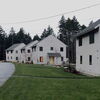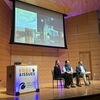Processing Your Payment
Please do not leave this page until complete. This can take a few moments.
- News
-
Editions
View Digital Editions
Biweekly Issues
- December 1, 2025
- Nov. 17, 2025
- November 03, 2025
- October 20, 2025
- October 6, 2025
- September 22, 2025
- + More
Special Editions
- Lists
- Viewpoints
-
Our Events
Event Info
Award Honorees
- Calendar
- Biz Marketplace
Vertical real estate | For wireless carriers, finding gaps in phone coverage is easy. Finding a place to build a tower or mount an antenna is another story.
What the Verizon commercials don't show you are the times when Test Man says "Dang." Numerous test people, at all the national wireless telecommunications companies, each put in thousands of miles a month in antenna-covered and electronics-laden cars to identify coverage gaps and drop-off points where the company needs to add antennas to improve service. What you also don't see in the Test Man commercials are the teams of employees trying to secure a site for those new towers or antennas, and possibly having to overcome a series of aesthetic worries and zoning regulations to erect them. And playing a unique version of the real estate game is where the most taxing work often comes into play for wireless networks.
"It's really the human characteristics that cause us to face our biggest challenges," says Mark Gartley, a Maine-based regional construction manager for Chicago-based U.S. Cellular. "People want airports for economic development, but they don't like the airplane noise; they want lots of electricity but don't want new power plants or hydro dams put up; they want smooth roads but don't want asphalt plants. And they want robust, clear cellular service but don't want towers."
Usually, the fear of a tower's visual impact is worse than its actual impact, Gartley says, and wireless carriers sometimes can convince a community to accept tower construction. But as cell phone providers continue to expand their networks in Maine, they're finding themselves continually adjusting to the needs and desires of individual communities, often with varying zoning codes covering towers and antennas.
Verizon, for example, spent $300 million in New England alone last year ˆ and has added 40 sites in Maine in the past six months to meet demand for voice and data services. But to handle that expansion, the company, like its competitors, has had to consider many alternatives to traditional towers, including placement of antennas on flagpoles and in municipal buildings, on top of business, atop fake trees, and inside church steeples.
The need for height
The first step in siting a new tower or antenna is identifying coverage deadzones. Verizon's in-the-field drivers alone conduct 750,000 voice call attempts and more than 1.4 million data tests quarterly on the company's own networks as well as those of rival wireless carriers, clocking in more than a million miles across the nation. Jim Holmes, U.S. Cellular's director of sales for New England, says his company follows a similar testing regimen, which he says is absolutely necessary. "You have to have people driving the network all the time to monitor the quality and the range of coverage," says Holmes. "That helps us reach our goal of catching network-related problems and gaps in coverage before customers do."
It also helps balance the sometimes-misleading data picture a company can get from "pristine environments on office-based computers," says Richard Enright, director of network operations for Verizon Wireless New England, who calls drive-testing the principal source of input for placing new cell towers. "You have to get a sense of the customer's experience and not just blindly accept data that comes out of our network monitoring systems," Enright says.
Before anyone starts talking about towers and antennas, though, typically a business case has to be made for whether the gap should be filled. The standard priority for wireless carriers is to make sure existing customers have coverage, then to make sure the quality of calls is good. Adding coverage to increase the customer base is third on the list. "You might want to provide service to a community with 50 people," says Holmes, "but with tower construction costs sometimes running several hundred thousand dollars, we may not be able to afford to do it."
Once a wireless company establishes whether there is a return on investment, the first solution it typically will employ is to see if modifications to existing sites and equipment can solve the problem or enhance the coverage. If not, the only answer often will be a new antenna, Enright says ˆ but that doesn't necessarily have to mean new tower construction. Engineers start drawing circles on topographical maps looking for candidate sites such as existing wireless towers, AM/FM towers and police and fire dispatch towers. Engineers also may explore non-telecom structures with significant height, such as water towers and tall buildings, to which antennas could be attached. "A tower is nothing more than a way to hold up an antenna," notes Gartley. "That's the physics of RF [radio frequency]. You need height to get your distance."
If no existing structures fit the bill, real estate professionals are then sent to take stock of what sites are available and, if necessary, talk with landowners, town planners and zoning officials. That is where the process can get sticky, particularly in Maine, which is known famously ˆ or infamously ˆ for having a fair number of decision-makers and residents who frown on anything that might detract from pristine views. After all, this is a state that bans billboards along the turnpike.
"The easiest, cheapest, most efficient and, frankly, the least obtrusive way to get antennas placed is to build a tower," Gartley says. "Yes, a typical tower in a rural area should be about 180 feet high, but here's the thing: When you're out driving, your eyes may see the towers around you, but your mind doesn't register most of them ˆ they are part of the landscape."
In a place like Falmouth, for example, which has some of the most stringent and restrictive rules for cell tower placement, attitudes about towers make it difficult to provide the cell coverage residents typically expect from companies, notes Dave Libby, a member of the Falmouth Town Council and an owner of towers throughout Maine used for a variety of telecom needs. "Consumers want their cell phones to work, but they don't want to see towers, and both feelings run strong in a more affluent place like Falmouth," laments Libby, who doesn't do business and "do battle" in his own community precisely because of such sentiments. "The funny thing is, they have no problem seeing telephone poles every 50 feet."
Sometimes, companies will resort to building monopole "trees" that are designed to blend in with existing tree lines, but people in the wireless industry have mixed feelings about those structures, believing they often stand out more than a simple tower or pole would. "I saw the ugliest camouflage tree tower recently on the Mass Pike, twice as tall as the real trees around it," Libby says. "I notice it every time I pass by it, while I hardly notice towers and poles at all."
Even when building a tower is an option, companies face issues of whether to own the land or lease it. There also are questions about securing hookups to power and telephone lines, meaning the entire siting process for a single tower can take anywhere from a year to a few years, Enright says.
This space for rent
What about when the option to build a tower doesn't exist? One option is to seek out businesses that already have cut through the red tape and can provide tower space for a price ˆ providers of what Gartley calls "vertical real estate."
Libby's company, Communications Facilities Inc., is a more-than-two-decade-old statewide example of that. His company operates more than 50 towers, primarily in northern Maine, and also provides design, construction, management and advisory services to wireless communications companies and to owners of communications towers, buildings and alternative structures in the northern part of the state. Sometimes, wireless carriers will approach such companies to find out if they can help meet coverage needs. Other times, Libby says, companies such as his will reach out to the wireless carriers to let them know when a new tower has become available for lease.
Communications Facilities does business with all the major cell phone players ˆ including Verizon, U.S. Cellular, T-Mobile and Sprint/Nextel ˆ as well as the Maine Turnpike Authority, Maine State Police and others. "There are companies that have become very big, largely by leasing vertical real estate to people like us," Gartley says. "It can be a very successful line of real estate to be in with wireless devices becoming so much more common and other issues like enhanced 911 coming up."
Gartley estimates that Verizon owns a third of its sites in New England and leases the remainder. The company is trending more toward leasing, he notes, and although he isn't entirely sure why, he thinks part of the reason is that landowners feel they can get more money over the long run by being telecom landlords than by selling their property outright.
Alternatives to towers and traditional tall structures also exist, in the form of high points such as church steeples and flagpoles. U.S. Cellular notes that some of its recent church installations include the First Parish Congregational Church in Yarmouth and the Cumberland Congregational Church in Cumberland.
But such "stealth sites" are often more expensive to wireless carriers and can also be less efficient technologically, Gartley says. Still, they often are necessary for a company to maintain a reputation as a good corporate citizen in locations where aesthetics are a concern. Hosting antennas also can be quite lucrative to the property owner. For example, the First Parish Congregational Church in downtown Yarmouth badly needed steeple repairs. So in 2004, U.S. Cellular not only agreed to provide the church with monthly lease payments to house an antenna in the steeple, it also picked up the steeple repair tab. (The company would not disclose the amount of the payments.)
Still, stealth sites may be the preferred option in many parts of Maine because of their low visual impact but potential economic benefit. A telecommunications infrastructure assessment plan prepared by Washington County last year described a number of wireless telecom antenna placement models, including stealth options such as water towers, farm silos, high tension lines, chimneys and steeples, and noted that Cellular One provided $30,000 to rehabilitate the steeple at the First Congregational Church in Newbury, Vt., as well as agreeing to pay $9,600 per year in rent for the space.
Stealth sites are common enough that churches in some regions increasingly see the wireless business as a way to shore up finances. For a church, a steeple is largely unused space, and wireless leasing arrangements have brought in anywhere from $500 to $4,000 a month to churches, depending on their location, notes the Rev. Stephen Sebastian, church liaison for SteepleCom, a company with offices in Ashby, Mass., and Durham, N.C., that creates wireless leasing opportunities for churches across the country and serves as an advocate for churches in all aspects of steeple rental contracts.
Although churches often benefit from hosting cell antennas, they need representation from a company like SteepleCom because many of them "don't know their own market value" and haven't gotten as much as they were worth, according to SteepleCom founder Tom Moylan.
Holmes of U.S. Cellular says flagpole antennas are another common option that can help both a wireless carrier and the local community, as they provide a location for public safety transmission equipment as well. U.S. Cellular recently added two flag pole antenna sites in Scarborough, he says. As Verizon's Enright notes, "a four-foot antenna in a steeple, on top of a building or on a flagpole is hardly going to do much to harm the visual appeal."
Enright also notes that his company, like other wireless providers, has been responsible for a lot of repair work at leased stealth sites, from upgrading electrical systems to fixing roofs and walls. "We've cleaned up environmental issues like buried oil tanks and asbestos at many sites because that's where towns wanted to put us," he says.
As proud as many wireless carriers are of such activities from a public relations standpoint, they would rather place more towers and have fewer stealth sites ˆ particularly as the capacity needs for networks increase with wireless devices handling not just voice but also data and video traffic.
As those demands increase, the need for new locations also increases, leaving wireless companies with a constant need to scour the state looking for tower sites and stealth sites ˆ and hoping they find open arms instead of closed minds. The more expensive the options become, particularly in rural areas where population density and profits for providing cell service dwindle, the slower high-capacity networks will spread from cities to more outlying areas, Enright notes. "The more remote the location, the more it will be questioned for a new antenna placement or an upgrade," he says. "Fortunately for Maine, there is, in addition to the year-round population, a sizable number of seasonal residents and tourists who demand wireless coverage while they're here, so it can make the business case and return on investment look a little better. But there is still only so much we can do and still remain profitable."
Pole position
Typical tower height: 100 ft. to 280 ft.
Size of actual cellular antenna: 4 ft.
Range of cellular transmission site: 1 to 5 miles
Amount of land needed: 2,500 to 10,000 sq. ft.
Mainebiz web partners

The Giving Guide
The Giving Guide helps nonprofits have the opportunity to showcase and differentiate their organizations so that businesses better understand how they can contribute to a nonprofit’s mission and work.
Learn More
Work for ME
Work for ME is a workforce development tool to help Maine’s employers target Maine’s emerging workforce. Work for ME highlights each industry, its impact on Maine’s economy, the jobs available to entry-level workers, the training and education needed to get a career started.
Learn More
Groundbreaking Maine
Whether you’re a developer, financer, architect, or industry enthusiast, Groundbreaking Maine is crafted to be your go-to source for valuable insights in Maine’s real estate and construction community.
Learn more-
The Giving Guide
The Giving Guide helps nonprofits have the opportunity to showcase and differentiate their organizations so that businesses better understand how they can contribute to a nonprofit’s mission and work.
-
Work for ME
Work for ME is a workforce development tool to help Maine’s employers target Maine’s emerging workforce. Work for ME highlights each industry, its impact on Maine’s economy, the jobs available to entry-level workers, the training and education needed to get a career started.
-
Groundbreaking Maine
Whether you’re a developer, financer, architect, or industry enthusiast, Groundbreaking Maine is crafted to be your go-to source for valuable insights in Maine’s real estate and construction community.
ABOUT
NEW ENGLAND BUSINESS MEDIA SITES
No articles left
Get access now
In order to use this feature, we need some information from you. You can also login or register for a free account.
By clicking submit you are agreeing to our cookie usage and Privacy Policy
Already have an account? Login
Already have an account? Login
Want to create an account? Register
Get access now
In order to use this feature, we need some information from you. You can also login or register for a free account.
By clicking submit you are agreeing to our cookie usage and Privacy Policy
Already have an account? Login
Already have an account? Login
Want to create an account? Register







Comments